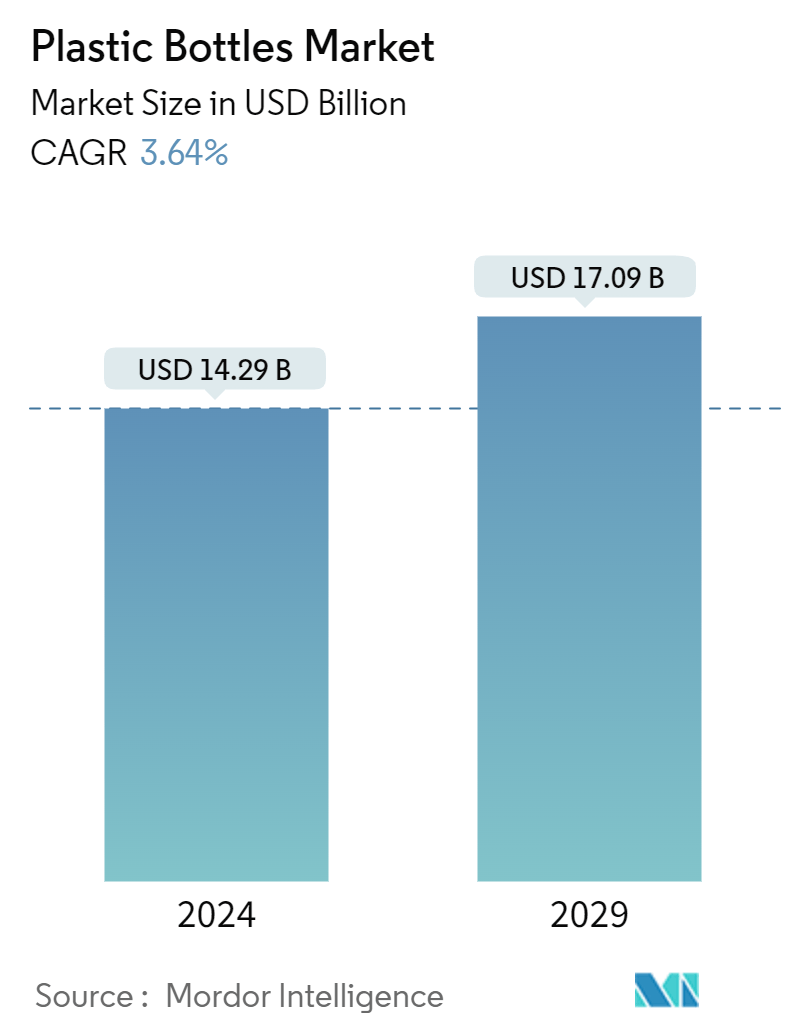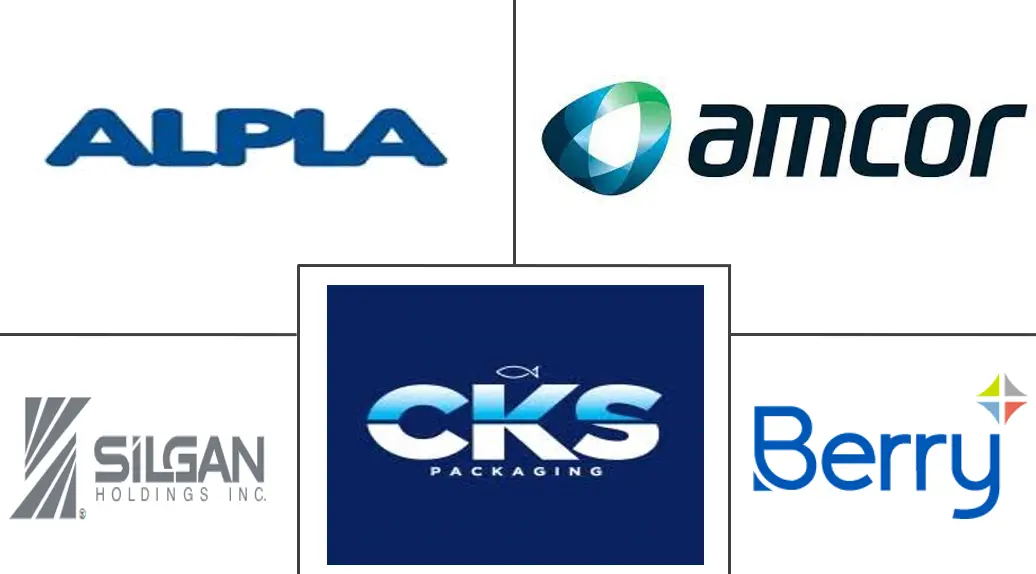Market Size of Plastic Bottles Industry

| Study Period | 2019 - 2029 |
| Market Size (2024) | USD 14.29 Billion |
| Market Size (2029) | USD 17.09 Billion |
| CAGR (2024 - 2029) | 3.64 % |
| Fastest Growing Market | Asia Pacific |
| Largest Market | Asia Pacific |
Major Players
*Disclaimer: Major Players sorted in no particular order |
Plastic Bottles Market Analysis
The Plastic Bottles Market size is estimated at USD 14.29 billion in 2024, and is expected to reach USD 17.09 billion by 2029, growing at a CAGR of 3.64% during the forecast period (2024-2029). In terms of production volume, the market is expected to grow from 15.39 billion tonnes in 2024 to 18.20 billion tonnes by 2029, at a CAGR of 3.42% during the forecast period (2024-2029).
Consumers globally increasingly favor plastic packaging due to its lightweight nature and ease of handling. Major manufacturers are gravitating toward plastic packaging solutions, primarily for their cost-effectiveness in production.
- Manufacturers widely favor plastic bottles crafted from materials like polyethylene terephthalate, polypropylene, and polyethylene. These materials are lightweight and unbreakable, enhancing the ease of handling. Additionally, manufacturers lean toward plastic packaging due to its cost-effectiveness. Given the rising reliance on packaged and processed foods and diverse beverages, the market for plastic bottles and containers is poised for growth during the forecast period.
- PET has become a vital packaging material among bottle manufacturers across the region. Its versatility in accommodating different shapes and sizes has provided unparalleled alternatives to conventional glass and metal containers, making it a highly desirable choice in the packaging industry.
- According to a report by PETnology, a global packaging networking platform, in July 2023, Asia is expected to take the lead in global PET industry capacity expansions, driven by new construction and expansion initiatives set to take place after 2023.
- Manufacturers prefer PET over other plastic packaging products, as it has a minimum loss of raw material during the manufacturing process compared to other plastic products. Its recyclability and the feature of adding multiple colors and designs augment it to become a preferred choice. Refillable products have emerged with rising consumer awareness of the environment and have acted to create demand for the product.
- As consumers increasingly prioritize high-quality drinking water, driven by concerns over tainted tap water and the inherent convenience of portability, the demand for bottled water surges. This growing appetite for bottled water, alongside the rising popularity of non-alcoholic beverages, is set to propel the plastic bottle market within the beverage industry.
- However, there is a growing inclination toward other packaging materials that offer environment-friendly properties. The consumption of aluminum cans and glass bottles has been witnessing high adoption rates in the region owing to its eco-friendly nature and high recyclability. Thus, consumers have been increasingly moving toward other materials from plastic.
Plastic Bottles Industry Segmentation
Plastic bottles generally include single-use and recyclable bottles made of plastic resins, such as PET, PP, and PE. These bottles are used by a comprehensive end-user industry, including food, beverage, and personal care. The plastic bottles market report offers an up-to-date analysis of the current market scenario, the latest trends and drivers, and the overall market environment. The study also identifies the continuous development of new products as a prime reason driving the plastic bottle market's growth during the next few years.
The plastic bottles market is segmented by resins (polyethylene (PE), polyethylene terephthalate (PET), polypropylene (PP), and other resins), end-user industry (food, beverage [bottled water, carbonated soft drinks, alcoholic beverages, juices and energy drinks, and other beverages], pharmaceutical, personal care and toiletries, industrial and household chemicals, paints and coatings, and other end-user industries), and geography (North America [United States and Canada], Europe [United Kingdom, Germany, France, Italy, Spain, Poland, Nordic, and the rest of Europe], Asia-Pacific [China, India, Japan, Thailand, Indonesia, Vietnam, Australia and New Zealand, and rest of Asia-Pacific], Latin America [Brazil, Colombia, Mexico, and rest of Latin America], and Middle East and Africa [Saudi Arabia, United Arab Emirates, Egypt, South Africa, Nigeria, Morocco, and rest of the Middle East and Africa]. The report offers market forecasts and size in volume (tonnes) and value (USD) for all the above segments.
| By Resin | |
| Polyethylene (PE) | |
| Polyethylene Terephthalate (PET) | |
| Polypropylene (PP) | |
| Other Resins (Polystyrene, PVC, Polycarbonate, etc.) |
| By End-user Industry | |||||||
| Food | |||||||
| |||||||
| Pharmaceuticals | |||||||
| Personal Care and Toiletries | |||||||
| Industrial | |||||||
| Household Chemicals | |||||||
| Paints and Coatings | |||||||
| Other End-user Industries |
| By Geography*** | |||||||||
| |||||||||
| |||||||||
| |||||||||
| |||||||||
|
Plastic Bottles Market Size Summary
The plastic bottle industry is experiencing significant growth, driven by the increasing preference for plastic packaging due to its lightweight and cost-effective nature. The adoption of polymers like polyethylene terephthalate (PET) and high-density polyethylene (HDPE) is expanding the applications of plastic bottling, particularly in the bottled and soft water markets. The global acceptance of plastic as a sustainable packaging solution has led major players, such as Amcor, to innovate and introduce new formats to meet rising demand. The recyclability and versatility of PET make it a preferred choice among manufacturers, further boosting its market presence. The industry's growth is also supported by initiatives from companies like Colgate-Palmolive and L'Oréal, who are committing to sustainable packaging solutions by 2025.
The demand for plastic bottles is anticipated to rise in the beverage sector, fueled by the ongoing preference for bottled water and non-alcoholic beverages. The convenience and portability of bottled water, coupled with concerns over water quality, are driving its popularity in both developed and developing economies. The alcoholic beverage sector is also contributing to market growth, with a shift towards plastic bottles in the wine industry observed recently. The Asia-Pacific region, despite efforts to reduce single-use plastics, may see increased plastic packaging usage due to the pandemic. Additionally, the healthcare and pharmaceutical sectors in countries like China and Japan are expected to drive demand for plastic bottles, supported by aging populations and regulatory changes. The market remains moderately competitive, with major players focusing on expanding their global presence and leveraging strategic collaborations to enhance profitability.
Plastic Bottles Market Size - Table of Contents
-
1. MARKET DYNAMICS
-
1.1 Market Overview
-
1.2 Industry Attractiveness - Porter's Five Forces Analysis
-
1.2.1 Bargaining Power of Suppliers
-
1.2.2 Bargaining Power of Buyers
-
1.2.3 Threat of New Entrants
-
1.2.4 Threat of Substitute Products
-
1.2.5 Intensity of Competitive Rivalry
-
-
1.3 Industry Value Chain Analysis
-
-
2. MARKET SEGMENTATION
-
2.1 By Resin
-
2.1.1 Polyethylene (PE)
-
2.1.2 Polyethylene Terephthalate (PET)
-
2.1.3 Polypropylene (PP)
-
2.1.4 Other Resins (Polystyrene, PVC, Polycarbonate, etc.)
-
-
2.2 By End-user Industry
-
2.2.1 Food
-
2.2.2 Beverage
-
2.2.2.1 Bottled Water
-
2.2.2.2 Carbonated Soft Drinks
-
2.2.2.3 Alcoholic Beverages
-
2.2.2.4 Juices and Energy Drinks
-
2.2.2.5 Other Beverages
-
-
2.2.3 Pharmaceuticals
-
2.2.4 Personal Care and Toiletries
-
2.2.5 Industrial
-
2.2.6 Household Chemicals
-
2.2.7 Paints and Coatings
-
2.2.8 Other End-user Industries
-
-
2.3 By Geography***
-
2.3.1 North America
-
2.3.1.1 United States
-
2.3.1.2 Canada
-
-
2.3.2 Europe
-
2.3.2.1 France
-
2.3.2.2 Germany
-
2.3.2.3 Italy
-
2.3.2.4 United Kingdom
-
2.3.2.5 Spain
-
2.3.2.6 Poland
-
2.3.2.7 Nordic
-
-
2.3.3 Asia-Pacific
-
2.3.3.1 China
-
2.3.3.2 India
-
2.3.3.3 Japan
-
2.3.3.4 Thailand
-
2.3.3.5 Australia and New Zealand
-
2.3.3.6 Indonesia
-
2.3.3.7 Vietnam
-
-
2.3.4 Latin America
-
2.3.4.1 Brazil
-
2.3.4.2 Mexico
-
2.3.4.3 Colombia
-
-
2.3.5 Middle East and Africa
-
2.3.5.1 United Arab Emirates
-
2.3.5.2 Saudi Arabia
-
2.3.5.3 Egypt
-
2.3.5.4 South Africa
-
2.3.5.5 Nigeria
-
2.3.5.6 Morocco
-
-
-
Plastic Bottles Market Size FAQs
How big is the Plastic Bottles Market?
The Plastic Bottles Market size is expected to reach USD 14.29 billion in 2024 and grow at a CAGR of 3.64% to reach USD 17.09 billion by 2029.
What is the current Plastic Bottles Market size?
In 2024, the Plastic Bottles Market size is expected to reach USD 14.29 billion.

